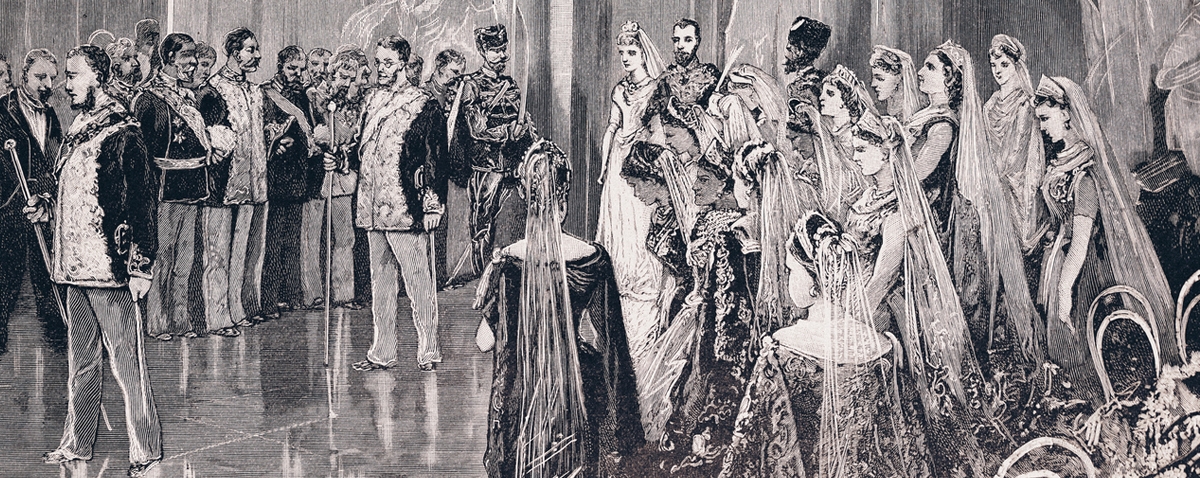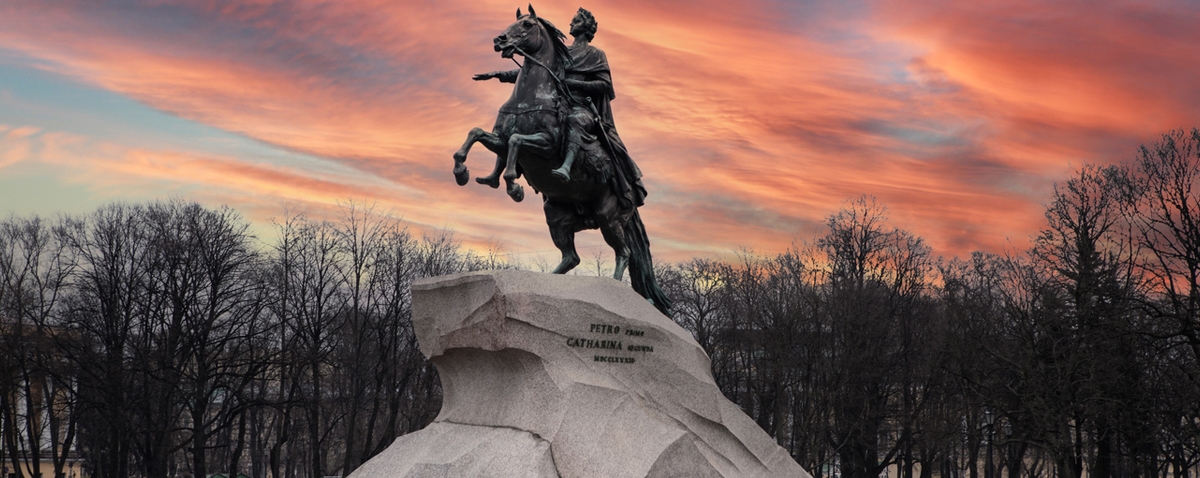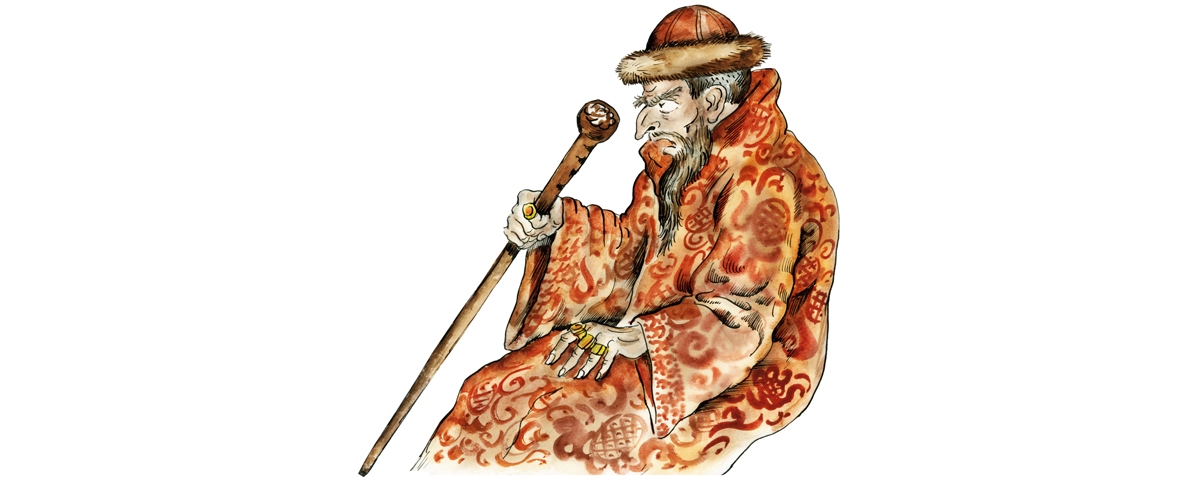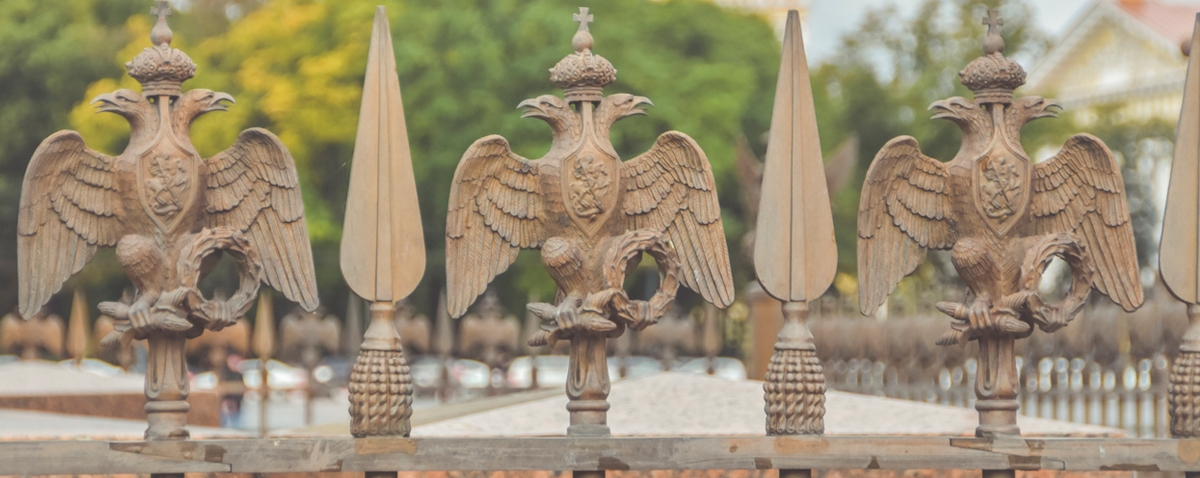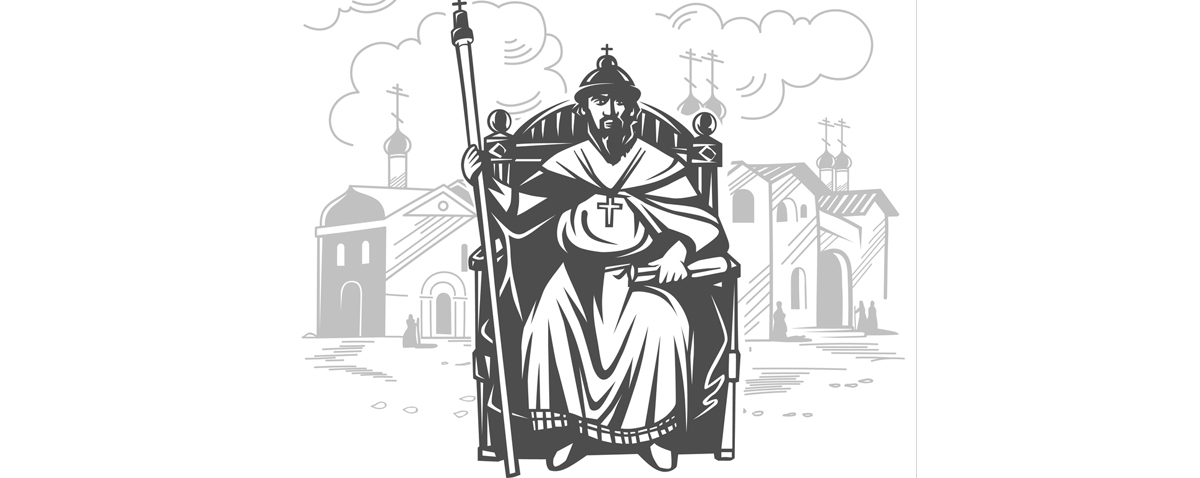Background
Russia is among the most powerful and influential countries in the world today. But did you know that around 400 years ago, the modern nation we know today did not exist? Instead, lots of Russian territories dotted the landscape during the middle ages. It was a perilous time for the Russian areas as they were immediate neighbors to the east and south, where aggressive Mongol khanates, the successor states of the Mongol Empire that had once ruled most of Russia. Without more support among the Russian states, they were endangered by falling back into being controlled by the Mongols. One of these Russian territories was Muscovy, ruled by Grand Prince Ivan of the Rurik dynasty in Moscow.[1]
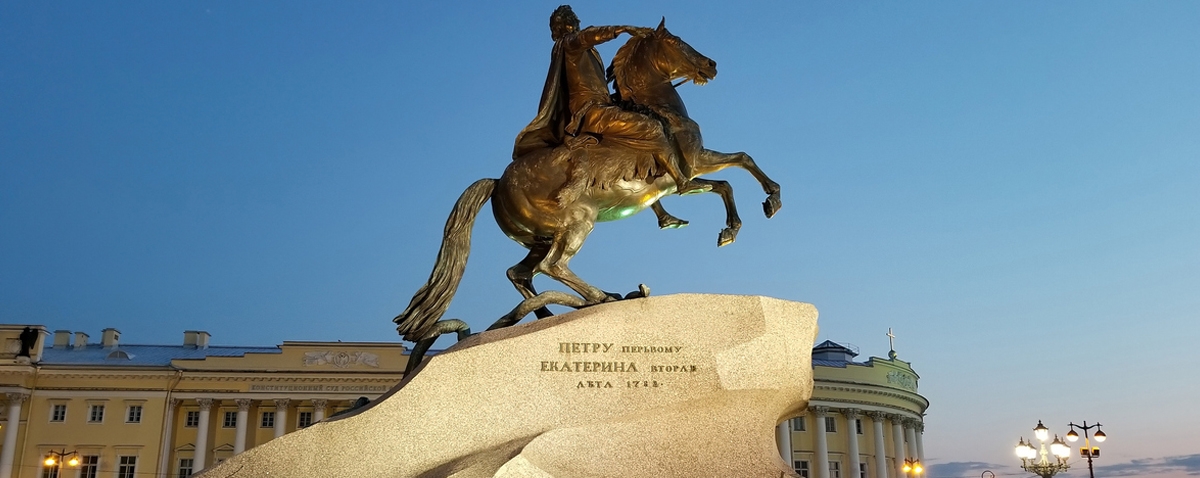
statue of Peter the Great

monument of Nicholas I in Russia

monument of Empress Elizabeth Petrovna
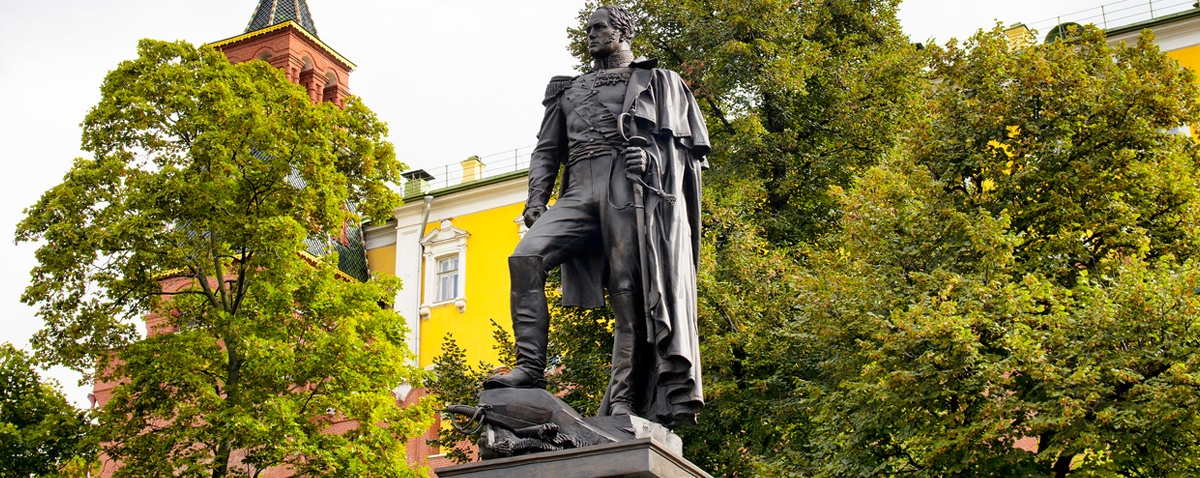
statue of Alexander I
Ivan IV would become the first czar of Russia, ordaining himself as the Russian monarch and creating a centralized Russian state grounded in Moscow. But what exactly is a Russian czar? What do you think was living in Russia under these czars? If you have the same questions, read on, as this article will help you learn more about the Russian czars.
What is a Czar?
Czar is also sometimes spelled as tzar or tsar. It is a title associated mainly with the rulers of Russia. The term czar is a form of the ancient Roman imperial title “Caesar,” which generated a series of derivatives in Russian, such as “tsarita,” which means a czar’s wife, “tsarina,” which means his son, “tsarevna,” which means his daughter, and “tsesarevich,” which means his eldest son and heir apparent.
In Russia in the middle ages, the title czar pertained to a supreme ruler, primarily the Byzantine emperor, who was considered the head of the Orthodox Christian world. However, all of the Byzantine Empire in 1453 and the conquest of the Ottoman Turns of the Balkans left the grand princes of Moscow the only remaining Orthodox monarchs in the world. With this, the Russian Orthodox clergy started to search for them as the defenders and possible supreme heads of Orthodox Christianity.
Some claims were made that Moscow would be the “3rd Rome” in succession to Constantinople, now Istanbul, and Rome itself. When 1472 came, Ivan III, the grand prince of Moscow, married Sofia Palaeologus, the niece of the last Byzantine emperor. Sofia brought with her the ethnicities of the Byzantine court and its concept of the dignified nature of monarchical power.
In 1547, Ivan IV, the Terrible, grand prince of Moscow, was crowned as the czar of all Russia. With this, the religious and political ideology of the Russian tsardom took final form. He held absolute power. However, in practice, his successors were limited by the traditional authority of the Orthodox church, the Boyar Council, and the legal codes of 1497, 1550, and 1649.[2]
Simply put, czar means an Emperor or a male monarch. It was the royal title of Russian rulers who reigned in Russia from the 16th century until the Bolshevik revolution in 1917. It also means a person who has great power.[3]
The History and Timeline of Russian Czars
During the ruling of the Russian czars, Russia had become a European superpower. The Russian czars were the rulers of Russia, whose reign started with Ivan the Terrible and ended with Nicholas II. The Russian czars reigned for more than 350 years.[3] Below is the history and timeline of the Russian czars.
In earlier times, the rulers of Russia were referred to as Grand Princes of Moscow, Grand Princes of Vladimir, Grand Princes of Kiev, and the likes. The most popular dynasty in Russia is the House of Romanov. However, the title “Czar” dates back to around 50 years before the Romanov emperors climbed the throne.[3]
The Rurikids:
1547 – 1584: Ivan IV the Terrible
As mentioned earlier, Ivan IV, known as Ivan the Terrible, was the first Russian ruler to become a czar in 1547. He belonged to the House of Rurik. He was an authoritarian and ruthless ruler. He was infamous for killing his son in a fit of rage.[3] Ivan IV revisited the Russian legislation in his Code of Laws of 1550, which established diplomatic relations with England and doubled the territory of Russia. In addition, his time was also popular for repressions against noble Moscow boyar families known as the oprichnina. This was why he was referred to as “the Terrible.” [4]
1584 – 1598: Fyodor I
Fyodor was the third son of Ivan the Terrible. He was not known to have taken part in governing the state. It was because almost all his days were spent praying, visiting monasteries, studying theology, the scriptures, and the like. Based on some historians, Fyodor deliberately removed himself from politics to avoid being poisoned, as his father probably was. During his reign, Russia was ruled by his wife’s brother, Boris Godunov, who became the next czar after the death of Fyodor.[4]
1598 – 1605: Boris Godunov
Boris Godunov was Czar Fyodor’s brother-in-law. He was probably the first Russian ruler who attempted to create cultural connections and cooperation between Europe and Moscow. However, he did not last long as a czar as he died under vague circumstances.[4]
1605 – 1605: Fyodor II
Fyodor Borisovich Godunov was the son of Boris Godunov. He received an excellent education and was well-acquainted with state affairs when his father died unexpectedly and ascended the Russian throne. However, his rule was challenged immediately by False Dmitry, who pretended and claimed to be the son of Ivan IV the Terrible. After the military commander shifted his support to the pretender, Fyodor’s mother attempted to take power and control the situation. However, her action provoked the hostility of the boyars, which triggered a Moscow mob to riot and murder his mother. After that, False Dmitry assumed the throne of Russia.[5]
1605 – 1606: Dmitry I
False Dmitry I was an impostor whose identity is debated until today. He posed as Dmitry, the last son of Ivan IV, who unbelievably survived a murder attempt. It was during the Time of Troubles when he took the Moscow throne with the help of the Polish-Lithuanian Commonwealth. He was crowned as the czar and reigned for about a year before he was executed by the people of Moscow when they found out about his deception.[4]
1606 – 1610: Vasili IV
Vasili IV Shuisky was the last Rurikid on the Russian throne. He became the czar after the uprising against False Dmitry I, which he ignited. However, he was not trusted among the Russian people. With this, he could not stop the ongoing revolts. That was why he was overthrown by the Moscow boyars in 1610 and tonsured as a monk by force. After two years, he died as a prisoner in Poland.[4]
The Romanovs:
1613 – 1645: Michael Romanov
Michael Romanov or Mikhail Fyodorovich was chosen as the czar at the Zemsky Sobor or people’s assembly in 1613. During his ruling, the Moscow Tsardom recovered after the disastrous Time of Troubles.
1645 – 1676: Alexei I
Alexei I or Alexey Mikhailovich was the second Romanov. He encouraged Russia’s trade and cooperation with Europe and invited European military men and engineers to the country. He was the one who introduced the Council Code or the Sobornoye Ulozhenie of 1649. He was also the father of Peter the Great.
1676 – 1682: Fyodor III
Fyodor II, or Fyodor Alekseevich, was the son of Alexei I, who inherited the throne. However, he had weak health and spent most of his time resting. During his short ruling, a population census was conducted, and the Russian military was studied and evaluated.
1682 – 1725: Ivan V and Peter I the Great
After the death of Fyodor III, Russia was governed by two czars at once. One was Ivan V (1682-1696), and the other was Peter I the Great (1682-1725). They were under the regency of their elder sister Sophia.
1682 – 1725: Peter I the Great
In 1696, the joint reign of Peter I and his brother ended. He began ruling the country as the full-fledged czar. He introduced some of the best reforms in Russian history, which involved politics, culture, economy, and more. He transformed Russia into a European military superpower by defeating Sweden in the Great Northern War from 1700 to 1721. Then, Russia was declared an Empire, and Peter became the first Russian Emperor.
1725 – 1727: Catherine I
According to the law on succession by Peter the Great, the sovereign must pick his successor before he dies. However, when Peter died, he did not specify a successor. With this, his wife, Empress Catherine I, was put on the throne as decided by a body of high-ranked statesmen led by Alexander Menshikov, who was Peter’s closest aide and friend. However, Catherine did not control politics. During those times, Menshikov was, in effect, the Russian ruler.
1727 – 1730: Peter II
Peter II was the grandson of Peter the Great. He climbed the throne when he was only 11 years old. However, he died at the age of 14 from smallpox. He did not have time to show any interest in state affairs. Therefore, instead of him ruling independently, the state was controlled by the statesmen in the Supreme Privy Soviet.
1730 – 1740: Anna Ioannovna
Anna was the daughter of Ivan V, the half-brother of Peter the Great. When Peter II died, Anna was invited by the Supreme Privy Council to be the sovereign, with specific restrictions on her power. However, after she was crowned, she disbanded the Supreme Privy Council and began ruling independently. Anna had a sturdy political stance and clever management, which helped Russia stand its ground against the Ottoman Empire during the war of 1733-1739.
In addition, Anna’s reign was also popular for the brutal rustic entertainment she introduced to the Russian court. She was an experienced shootist, and once, she ordered a jester wedding to be held in an ice palace.
1740 – 1741: Ivan VI
After the death of Anna, the throne was left to Ivan VI, the 1-year-old son of her niece Anna Leopoldovna, who became the advisor of Russia. Ivan VI reigned for less than a year and was replaced by Elizabeth, the descendant of Peter the Great. Ivan spent his life in confinement. He died when he attempted to escape his prison cell.
1741 – 1761: Elizabeth Petrovna
Elizabeth was the daughter of Peter the Great. She was the last Russian on the throne. Her 20-year ruling was popular for successful foreign policy, wherein Russia stood its ground in wars against Sweden and the Seven Years’ War, developing arts and sciences to add further to the tax burdens of the population.
1761 – 1762: Peter III
Peter III was the grandson of Peter the Great. He became the next czar after Elizabeth. He began living in Russia in 1742. He reigned for only half a year, and then he was ousted by his wife, Catherine. He was murdered soon after the rebellion.
1762 – 1796: Catherine II the Great
Catherin II’s reign earned her the title of “the Great” for many reasons. These include the territorial expansion of the Empire, the political development, and the proliferation of sciences, which she encouraged. However, she also took big loans from European states. By the end of her reign, the Empire was left with a huge external debt.
1796 – 1801: Paul I
Paul was Catherine and Peter III’s son. He became the Emperor of Russia at 42 after his mother died. During his short reign, he began many major reforms in the military sphere and in Russian politics. However, Paul was killed in a rebellion pulled off by a group of high-ranked statesmen who were against his domestic and foreign policy.
1801 – 1825: Alexander I
The reign of Alexander was marked by the expansion of culture and arts, as well as by the Patriotic War of 1812. In this war, Russia conquered the Great Army of France led by Napoleon Bonaparte. The French invaded its borders and went as far as conquering Moscow. However, Alexander unexpectedly passed away in 1825 in the town of Taganrog in Southern Russia.
After the death of Alexander, an attempted coup d’état called the Decemberists Revolt occurred on December 14, 1825. It was led by a group of aristocratic military officers. However, the revolt was suppressed by Nicholas I, the next Emperor, through military force.
1825 – 1855: Nicholas I
Nicholas was the third son of Paul. He was the one who started the railroad construction in Russia, which boosted the nation’s industrialization. His reign’s successes include codifying Russian laws and financial reform. However, strong corruption in military-led Russia led them to lose the Eastern War of 1853-1856. Before the war ended, Nicholas I passed away.
1855 – 1881: Alexander II
Alexander II was the son of Nicholas I. He began major reforms in Russia that included the peasant liberation of 1861, the introduction of new types of self-governing village societies, an all-encompassing military reform, and more. However, the freedom of serfs brought a social disruption, and terrorist groups appeared. There were five attempts to take his life, and the 6th one was fatal. Alexander II was killed by a terrorist bomber on March 1, 1881.
1881 – 1894: Alexander III
Alexander III, son of Alexander II, was popular for being peaceful. Under his reign, the nation did not participate in any wars. His domestic policy, however, was strictly conservative. The state police and intelligence organs could not suppress the revolutionary activities already in effect in Russian society. During his reign, Lenin and Stalin, the future founders of the USSR, began their revolutionary activities.
1894 – 1917: Nicholas II
The last Russian Emperor or czar was Nicholas II. He did not have a successful policy, which led to the Revolution of 1905, which shuddered Russian society enormously. The State Duma, the first official Russian parliament, was established after the Revolution. However, it did not change the course of events.
In 1917, three years after World War I started, the Russian Empire ceased to exist after Nicholas II abandoned the Russian throne. He and his family were later murdered by a gang of Bolsheviks in Yekaterinburg.[4]
The Population of the Russian Empire
Below is some information about the population of the Russian Empire:
Demographic History of the Russian Empire
According to KMLA, the population of the Russian Empire, as seen in the graph above, was 14 million in 1722, 19 million in 1762, 35.5 million in 1800, 74.1 million in 1860, 126.4 million in 1897, and 170.1 million in 1913. However, these figures only pertain to the population of European Russia, and the date for the whole Russian Empire exceeds it.[6]
Population Growth of Major Cities in European Russia (1800-1910) | |||||
City | 1800 | 1850 | 1870 | 1980 | 1910 |
Ekaterinoslav | 9,000 | 12,000 | 24,000 | 47,000 | 196,000 |
Kazan | 54,000 | 45,000 | 79,000 | 134,000 | 188,000 |
Kharkov | 10,000 | 25,000 | 60,000 | 188,000 | 236,000 |
Kiev | 23,000 | 50,000 | 71,000 | 184,000 | 505,000 |
Minsk | 11,000 | 24,000 | 36,000 | 71,000 | 101,000 |
Moscow | 250,000 | 365,000 | 612,000 | 799,000 | 1,533,000 |
Nizhny Novgorod | 14,000 | 31,000 | 41,000 | 73,000 | 109,000 |
Odessa | 6,000 | 90,000 | 121,000 | 314,000 | 506,000 |
Rostov (Don) | 4,000 | 13,000 | 39,000 | 67,000 | 121,000 |
Sankt Petersburg | 336,000 | 485,000 | 667,000 | 1,003,000 | 1,962,000 |
Samara | 4,000 | 24,000 | 34,000 | 95,000 | 96,000 |
Saratov | 27,000 | 64,000 | 93,000 | 123,000 | 206,000 |
The graph above shows the population growth of major cities in European Russia from 1800 to 1910.
The Most Important Russian Czars
You’ve seen many czars reigned in Imperial Russia on the timeline we shared earlier. But among those czars, here are the most important ones in history:
Ivan the Terrible
Ivan, the first Russian czar, has gotten a bad rap as he did terrible things during his reign. One of those was beating his son to death using his wooden scepter. But he is also praised in Russian history for greatly expanding Russian territory and establishing trade relations with England. In addition to that, he also brutally conquered the most powerful nobles in his kingdom, which were the Boyars. He established the principle of absolute autocracy.
Boris Godunov
Boris Godunov ruled for seven years. He allowed young Russian nobles to study elsewhere in Europe. Aside from that, he also imported teachers into his empire and cozied up to the kingdoms of Scandinavia, wanting peaceful access to the Baltic Sea. He also made it illegal for Russian peasants to transfer their loyalty to another noble. This cemented in place a key component of serfdom. When he died, Russia entered the “Time of Troubles,” which included civil war between opposing Boyar factions, famine, and open interfering affairs by the nearby kingdoms of Sweden and Poland.[7]
Michael I
Michael was important as he was the first Romanov czar. He started the dynasty that ended 300 years later with the 1917 Revolutions. Since Russia was devastated after the Time of Troubles, Michael I had to wait for weeks before a suitable intact palace could be found for him in Moscow. He had 10 children with Eudoxia, his wife. However, only 4 of them lived into adulthood. However, that was enough to continue the Romanov dynasty.
Peter the Great
Peter the Great was best known for his ruthless attempts to westernize Russia and import the principles of the Enlightenment into what the rest of Europe still viewed as a backward and medieval country. He was the one who rearranged the Russian military and bureaucracy along Western lines. He required the officials to shave their beards and dress in Western clothes. His most popular achievement was defeating the Swedish army in the Battle of Poltava in 1709, raising the esteem of the Russian military in Western eyes.[7]
Elizabeth of Russia
Elizabeth reigned for 20 years. In that period, she endured two major conflicts. One was the Seven Years’ War, and the other was the War of the Austrian Succession. She was best known for establishing the University of Moscow and spending lots of money on different palaces.
Catherine the Great
During the reign of Catherine, Russia greatly expanded its borders. It absorbed Crimea, divided Poland, annexed territories along the Black Sea, and settled the Alaskan territory that was later sold to the United States. She also continued the Westernization policies that were started by Peter the Great.[7]
Alexander I
Alexander formed a “holy alliance” with Prussia and Austria to counter the rise of liberalism and secularism. He even rolled back some domestic reforms from earlier in his reign. Some examples were removing foreign teachers from Russian schools and instituting a more religious curriculum. He also became paranoid and distrustful, constantly fearing kidnapping and poisoning.
Nicholas I
During the reign of Nicholas I, he succeeded in keeping up appearances until the Crimean War of 1853, when the much-vaunted Russian army was revealed as poorly disciplined and backward. It was also discovered that there were fewer than 600 miles of railroad tracks in the country during this time, compared to more than 10,000 miles in the United States. He died in 1855 of natural causes.
Alexander II
Alexander II was also known as Alexander the Liberator. It was because he freed Russia’s serfs. He also reformed the Russian penal code, investing in Russian universities and revoking some of the much-resented rights of the nobility. He also sold Alaska to the United States. The autocratic Russian government was under intense pressure from different revolutionaries under his reign. In 1881, he was assassinated after numerous unsuccessful attempts.
Nicholas II
Nicholas II was the last czar of Russia. At 13, he saw how his grandfather, Alexander II, was assassinated. Due to this trauma, he had ultra-conservative policies during his reign. His reign was an unbroken series of disasters. Some of these include the strange accession to power and influence of the unhinged Russian monk Rasputin, being defeated in the Russo-Japanese War, and the 1905 Revolution, which established the first-ever democratic body of Russia which was the Duma.
During the Revolutions in 1917, Nicholas II was overthrown by Communists led by Vladimir Lenin and Leon Trotsky. After a year, he and his whole family were murdered during the Russian Civil War in Yekaterinburg. These assassinations put a bloody end to the Romanov dynasty.[7]
The Difficulties in Governing the Tsarist State
Here are some of the complications when it comes to governing the tsarist state:
Size of the Russian Empire
The wide-ranging corners of the Empire, which were thousands of miles from Moscow, often proved ungovernable. However, the scale of the Empire, the poor infrastructure, and the nature of the population also made it challenging for opposition to the Czar to grow. In addition, most of the population back then was illiterate peasant farmers. The size of the Russian Empire also made it challenging to spread liberal or revolutionary ideas through books and pamphlets. The poor condition of the roads and railways also made it difficult for the ideas to spread, making it hard for the people to unite a challenge to the czar.
Revolutionary Ideas
Due to the unlimited power of the czar, the only way to challenge the Tsarist autocracy was through acts of rebellion. Groups from the opposition started to grow as a consequence of successive czar’s refusal to grant reform and improve living conditions. Liberals wanted the evolving middle class to have increased political influence. Western European countries had created constitutional governments and improved political rights for their citizens. A lot of liberal thinkers wanted the same for Russia.
Populism existed in the schools while the People’s Will attempted to assassinate Alexander III in 1887. In the late 1800s, Marxist thinking had developed in Russia. The idea of Karl Marx that power should be in the hands of the masses was promoted. With this, revolutionary groups that combined the aims of Marx were developed with their own goals.
The Social Revolutionaries implemented a combination of Marxist and Populist beliefs. They wanted to take over the government in favor of giving power to the peasants. Even though they were greatly uncoordinated in their efforts, they carried out around 2,000 political killings in the years leading up to the 1905 Revolution.
Corruption and Incompetence
The Russian Civil Service was seen as backward and selfish when the century ended. Many civil servants were poorly paid, which resulted in widespread bribery. Promotion depended more on years of service rather than competence. There were lots of bureaucrats that had little understanding of the importance of industrialization. Also, the vast expanse of the Russian Empire meant that taxation was challenging to organize and police. With this, governmental income was usually inadequate.[9]
Tsarist Methods of Control – Policies
Here are the different methods of control that the Russian czars used:
Censorship
During the time of the Russian czars, censorship was widespread in Russia. People were restricted from practicing their freedom of speech. All the books and newspapers in the country were blocked so the people would not be influenced by either liberal or socialist ideas. Any material that was thought to be threatening was banned. Any person that tried to circulate banned books or newspapers was at risk of being detected by the Okhrana.
Russification
This was the policy of imposing Russian culture on the huge number of ethnic minorities that lived in the Russian Empire. This policy greatly affected the Poles, Lithuanians, and Ukrainians. Russian was the official language, and other languages were suppressed. In addition, Russian Orthodoxy was promoted, and Catholic monasteries were closed.
During the reign of Nicholas II, the Black Hundreds was created. It was an extreme nationalist movement that supported the Tsar. This movement murdered pro-democratic politicians and frightened the workers in the metropolises.
Terror and Exile
Fear of the Okhrana was prevalent during those times, resulting from the czars’ considerable power and terrifying tactics. This helped suppress any opposition to the czar. The Okhrana was able to censor any material that was deemed unsuitable. It had a network of spies that infiltrated the political organizations. This made it challenging to tell if a recruit was a genuine revolutionary or an Okhrana agent.
The people who were suspected of opposing or criticizing the state did not have the right to a trial. They were stated and sentenced immediately. Political prisoners were usually exiled to Siberia.[9]
Interesting Facts About the Russian Czars
If you want to learn more about the Russian czars, here are some of the most interesting facts that might blow your mind.
- Alexis, the 2nd Romanov czar of Russia, was known as mild and gentle-tempered. However, when a peasant was charged with leading a failed revolution in 1670, the peasant was whipped, tortured, branded with hot irons, and cut into quarters while still alive. This changed its reputation of Alexis.
- When brothers Ivan V and Peter I became czars, their older sister Sophia was behind them, whispering instructions. She sat in a chair behind the thrones and whispered orders.
- Among the czars, Peter the Great was the most hands-on. He was known to hack off the heads of his enemies himself. Most czars just hired executioners to do it.
- Peter the Great also had a kinship for education. In fact, he took the opportunity of his mistress Mary Hamilton’s beheading in 1719 to discuss her windpipe, vertebrae, and carotid arteries to the crowd.
- Empress Anna was very fond of firearms. Wild beasts around Russia were collected and brought to her estates so she could shoot them at will.
- Empress Anna also had ridiculous inclinations. One example was forcing her noblemen to act like fools and sit in giant nests while covered in feathers. This was her idea of having fun.
- Empress Elizabeth was fond of cross-dressing. She often ordered men to dress like women and women to dress like men. However, no one ever pulled it off as well as she did.
- Alexander II had the bravery to free Russia’s serf, leading to seven assassination attempts against him. The last one, which occurred in 1881, proved successful.
- Nicholas II was not ready to ascend the throne even when he was crowned emperor. With this, when asked about critical government matters, he responded with, “Ask my mother.”
- Ivan the Terrible ruled Russia with a gory fist before the Romanovs came to power. He was known for ordering that his enemies be burned, skinned, boiled, and broken. Ivan the Terrible was the favorite czar of Joseph Stalin.
- The wife of czar Alexis was especially courageous. When most women stayed hidden behind closed doors, she dared open her carriage window for a bit.
- Peter the Great loved dwarfs and kept a lot at a time. He even had a naked dwarf jump out of a giant pie for amusement.
- Empress Elizabeth had to shave her head after a botched dye job. With this, no one was allowed to walk around with heads full of hair. Therefore, all women in the court were also made to cut their hair.
- Nicholas I would travel the country to snoop on his subjects himself. One time, he visited a high school and scolded the director for having ugly pupils.
- Catherine the Great had a procession of young lovers into her sixties. A number of them were younger than half her age.
Conclusion
Tsarist Russia went through changes over many years, with prevailing complexes of cultural inferiority felt by the people. The Russian Empire worked like an absolute monarchy on the ideological doctrine of Orthodoxy, Autocracy, and Nationality until the Revolution of 1905. It performed poorly during the First World War, which led to a revolution and the abdication of Czar Nicholas II, after which the monarchy was abolished.
It can be quite difficult today to imagine what the people in Russia have been through under the czars. But some instances may also feel familiar even today, especially concerning issues about corruption that many governments in the world are facing. We hope this article helped you learn more about the Russian czars.
References
[1] Davidson, H. (2019, August 21). Russian Czars: History & Timeline. Study.com | Take Online Courses. Earn College Credit. Research Schools, Degrees & Careers. Retrieved February 9, 2022, from https://study.com/academy/lesson/russian-czars-history-timeline.html
[2] Britannica, E. T. (2016, March 30). Tsar. Encyclopædia Britannica. Retrieved February 9, 2022, from https://www.britannica.com/topic/tsar
[3] Historyplex, E. (2009, June 12). A glance at the troubled history and Timeline of Russian czars. Historyplex. Retrieved February 9, 2022, from https://historyplex.com/history-timeline-of-russian-czars
[4] Russia Beyond, E. (2021, August 10). The complete list of Russian tsars, emperors and presidents. Russia Beyond. Retrieved February 9, 2022, from https://www.rbth.com/history/334065-complete-list-of-russian-tsars-emperors-rulers-presidents
[5] Britannica, T. Editors of Encyclopaedia (2022, January 1). Fyodor II. Encyclopedia Britannica. Retrieved February 9, 2022, from https://www.britannica.com/biography/Fyodor-II
[6] Korean Minjok Leadership Academy, E. (2008, March 30). Demographic History of European Russia 1796-1917. WHKMLA: Russian Empire 1796-1917 – Demographic history. Retrieved February 9, 2022, from https://www.zum.de/whkmla/region/russia/eurrusdemhist17961917.html
[7] Strauss, B. (2019, August 7). These autocrats ruled Russia for centuries before the Soviet Union. ThoughtCo. Retrieved February 9, 2022, from https://www.thoughtco.com/most-important-russian-tsars-4145077
[8] Malinsky, G. (2014, July 8). 20 facts about the Russian tsars. Mental Floss. Retrieved February 9, 2022, from https://www.mentalfloss.com/article/57674/20-facts-about-russian-tsars
[9] BBC, E. (2020). Factors affecting the security of the Tsarist state before 1905 – security of the Tsarist state before 1905 – higher history revision – BBC bitesize. BBC News. Retrieved February 14, 2022, from https://www.bbc.co.uk/bitesize/guides/z9qnsbk/revision/1
[10] Malinsky, G. (2014, July 8). 20 facts about the Russian tsars. Mental Floss. Retrieved February 14, 2022, from https://www.mentalfloss.com/article/57674/20-facts-about-russian-tsars

